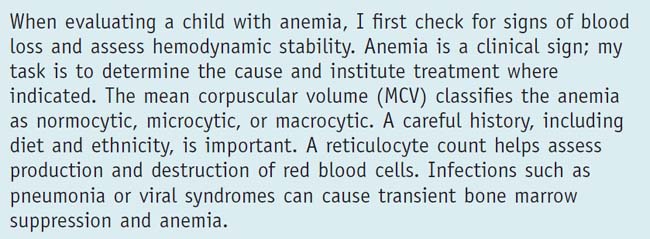Chapter 45 Anemia (Case 15)
Patient Care
Clinical Thinking
• Physiologic anemia of infancy (resulting from multiple factors related to transition to extrauterine life) results in a progressive drop in hemoglobin in the first 8 weeks of life in term infants to 9 to 11 g/dL. In preterm infants, the drop occurs in the first 3 to 6 weeks and is more severe—to 7 to 9 g/dL. No treatment is required: iron stores are adequate, and recovery occurs as erythropoietin increases.
Table 45-1 Age-Specific Hemoglobin
| Age | Hemoglobin (g/dL)* |
|---|---|
| 1-3 days | 18.5 (14.5) |
| 2 weeks | 16.6 (13.4) |
| 1 month | 13.9 (10.7) |
| 2 months | 11.2 (9.4) |
| 6 months | 12.6 (11.1) |
| 6 months-2 years | 12 (10.5) |
| 2-6 years | 12.5 (11.5) |
| 6-12 years | 13.5 (11.5) |
| 12-18 years | |
| Male | 14.5 (13) |
| Female | 14 (12) |
| Adult | |
| Male | 15.5 (14) |
| Female | 14 (12) |
Data from Oski FA, Naiman JL: Hematological problems in the newborn infant, Philadelphia, Saunders, 1982; Nathan D, Oski FA: Hematology of infancy and childhood, Philadelphia, Saunders, 1998; Matoth Y et al: Postnatal changes in some red cell parameters. Acta Paediatr Scand 1971;60:317; and Wintrobe MM: Clinical hematology, Baltimore, Williams & Wilkins, 1999.
History
• Review newborn screen results: note G6PD deficiency, sickle cell disease, or Bart’s hemoglobin (indicating α-thalassemia trait).
• What is the child’s ethnicity? African, Asian, and Mediterranean ancestry is associated with β-thalassemia trait; and Southeast Asian, Chinese, and African heritage with α-thalassemia trait.
Tests for Consideration
• Complete blood count (CBC) with differential: To check hemoglobin, MCV, platelets, and white blood cells to distinguish anemia from pancytopenia $116
• Reticulocyte count: To check bone marrow response; increased with hemorrhage, hemolysis, or recent treatment of iron deficiency $74
Stay updated, free articles. Join our Telegram channel

Full access? Get Clinical Tree



